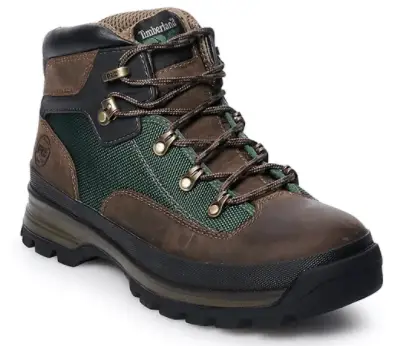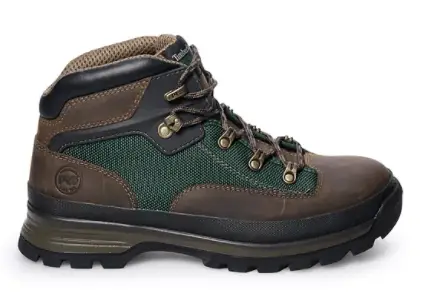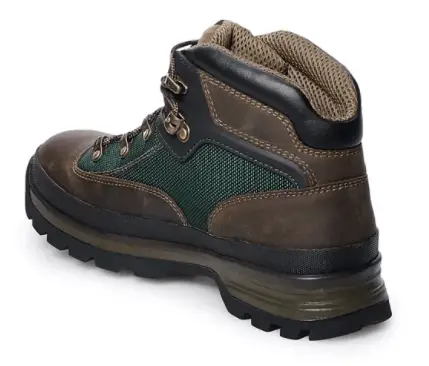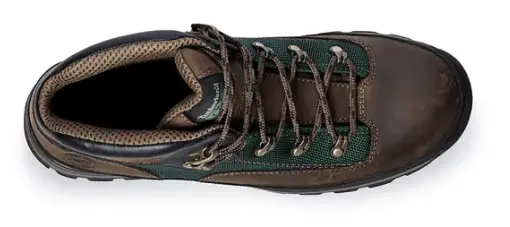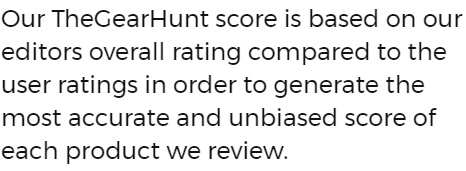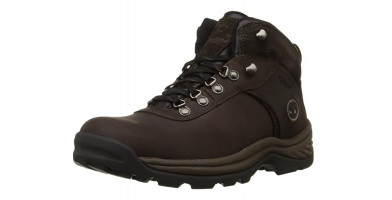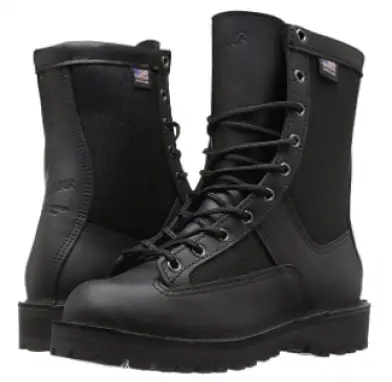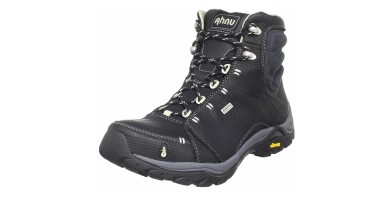Timberland Pro Euro Hiker
Editor’s Conclusion
The Timberland Euro Hiker comes in two versions a full leather upper and this model which we take a look at, with leather and textile uppers.
The key to choosing the best footwear is to look closer at the purpose of design. This boot is primarily designed for use during spring and fall. For those looking to hike in warmer seasons, this boot will perform.
For better traction and support these boots give a lower center of gravity due to a wider sole platform.
For hikers and backpackers, this is a good "use in context boot" and as a work boot, the feedback for durability suggests moderately good but could be better. The price is well within affordable for a popular brand, and they're available in all standard widths and extra width versions.
The key to choosing the best footwear is to look closer at the purpose of design. This boot is primarily designed for use during spring and fall. For those looking to hike in warmer seasons, this boot will perform.
For better traction and support these boots give a lower center of gravity due to a wider sole platform.
For hikers and backpackers, this is a good "use in context boot" and as a work boot, the feedback for durability suggests moderately good but could be better. The price is well within affordable for a popular brand, and they're available in all standard widths and extra width versions.
Editor's Pros & Cons
Pros
Leather and ballistic nylon upper
Vibram sole
Spacious toe box
Padded tongue/collar
Durability when used within the boot's intended range
Cons
Breathability could be better
Use only in spring and fall
Cushioning subject to wear and tear
Timberland Pro Euro Hiker
Comfort and Support
For comfort with support, the uppers are a combination of premium durable leather and ballistic nylon (synthetic textile). The boot weight is 1.69 pounds, reasonably light in comparison to many similar-sized boots from other brands.
The leather forms the lower section of the uppers for the toe and heel area and is designed to extend up and around the ankle. The ankle cuff and tongue are padded leather for more support while keeping out dirt and grit. Ballistic nylon panels (textile) are stitched into the boot on both sides as part of the structure of the upper and extends to house the lace-up system,
The comfort level is good with an EVA blended foam midsole. The cushion level is enough to protect from uncomfortable rubbing and blistering. User feedback does mention that with very regular long-distance hiking the midsole will be subject to notable thinning/wear and tear.
A steel shank ensures nice support and durability. For accurate FIT do use the Timberland sizing chart and these will require minimal breaking-in.
The D-Ring lace-up system gives the wearer control over how tight the laces can be made and works nicely with the supportive ankle collar.
Materials and durability
The level of comfort does give a sense of reliable durability.
Leather has a long history of outdoor footwear use because of tried and tested durability. The longevity of leather is determined by the thickness, quality, and care taken to treat the leather.
Users do point out that the leather could be thicker. The choice of leather thickness for the Euro Hiker is dictated by the purpose of the design. These boots are for warmer weather hiking and less thickness means a more supple leather with a degree of breathability. If the boot is regularly used in tough weather conditions this will have a significant impact on durability.
The ballistic nylon membrane panels certainly offer durability and this contributes towards balanced structural support from the uppers. The stitching for the uppers is good quality and durability holds well.
This is not a stitch-down boot, The Vibram rubber soles are known for standing up to challenging surfaces while retaining durability.
Traction
The Vibram rubber sole features an aggressive lug patterning which means that traction is impressive and dependable. Wet and dry surfaces are not overly challenging for traction, the sole does have a lot of rigidity with some limited flexibility in the soles mid-region.
As these are warm-weather hiking boots. User feedback does highlight that in very wet conditions, the traction is good but at times the sole can pick up some wet clinging mud.
Waterproofing and breathability
This version of the Euro Hiker does not feature a Gore-Tex lining due to its design purpose for warm weather hiking. The lower section of the upper is leather and that means protective waterproofing up to around 2 inches from ground level. Leather offers a natural amount of waterproofing but has limitations.
The ballistic nylon uppers have a tight weave which will keep water out of the boot but again with limitations.
During warm weather, rainfall and wet surfaces do happen and the level of protection in such conditions is good. Stepping in shallow puddles, waterproofing is absolute for a depth of around 2 inches. For long wet grass, constant rain, sleet, or snow these boots are not designed for this level of waterproofing. For wet weather hiking check-0ut the Timberland Chocorua Trail 2.0. The overall breathability is average for a warm-weather boot.
For comfort with support, the uppers are a combination of premium durable leather and ballistic nylon (synthetic textile). The boot weight is 1.69 pounds, reasonably light in comparison to many similar-sized boots from other brands.
The leather forms the lower section of the uppers for the toe and heel area and is designed to extend up and around the ankle. The ankle cuff and tongue are padded leather for more support while keeping out dirt and grit. Ballistic nylon panels (textile) are stitched into the boot on both sides as part of the structure of the upper and extends to house the lace-up system,
The comfort level is good with an EVA blended foam midsole. The cushion level is enough to protect from uncomfortable rubbing and blistering. User feedback does mention that with very regular long-distance hiking the midsole will be subject to notable thinning/wear and tear.
A steel shank ensures nice support and durability. For accurate FIT do use the Timberland sizing chart and these will require minimal breaking-in.
The D-Ring lace-up system gives the wearer control over how tight the laces can be made and works nicely with the supportive ankle collar.
Materials and durability
The level of comfort does give a sense of reliable durability.
Leather has a long history of outdoor footwear use because of tried and tested durability. The longevity of leather is determined by the thickness, quality, and care taken to treat the leather.
Users do point out that the leather could be thicker. The choice of leather thickness for the Euro Hiker is dictated by the purpose of the design. These boots are for warmer weather hiking and less thickness means a more supple leather with a degree of breathability. If the boot is regularly used in tough weather conditions this will have a significant impact on durability.
The ballistic nylon membrane panels certainly offer durability and this contributes towards balanced structural support from the uppers. The stitching for the uppers is good quality and durability holds well.
This is not a stitch-down boot, The Vibram rubber soles are known for standing up to challenging surfaces while retaining durability.
Traction
The Vibram rubber sole features an aggressive lug patterning which means that traction is impressive and dependable. Wet and dry surfaces are not overly challenging for traction, the sole does have a lot of rigidity with some limited flexibility in the soles mid-region.
As these are warm-weather hiking boots. User feedback does highlight that in very wet conditions, the traction is good but at times the sole can pick up some wet clinging mud.
Waterproofing and breathability
This version of the Euro Hiker does not feature a Gore-Tex lining due to its design purpose for warm weather hiking. The lower section of the upper is leather and that means protective waterproofing up to around 2 inches from ground level. Leather offers a natural amount of waterproofing but has limitations.
The ballistic nylon uppers have a tight weave which will keep water out of the boot but again with limitations.
During warm weather, rainfall and wet surfaces do happen and the level of protection in such conditions is good. Stepping in shallow puddles, waterproofing is absolute for a depth of around 2 inches. For long wet grass, constant rain, sleet, or snow these boots are not designed for this level of waterproofing. For wet weather hiking check-0ut the Timberland Chocorua Trail 2.0. The overall breathability is average for a warm-weather boot.
Comparatives
Durability, support, and comfort result from the design purpose for this boot. It is good for warm weather hiking and even performs as a work boot.
There is some user feedback that suggests the boot's actual construction/structure could be more durable. This raises questions on two levels, perhaps the durability could be better, or is the boot being used beyond its design purpose? Interestingly, the majority of user feedback shows a good amount of satisfaction.
In comparative terms, it is worth looking at a boot option from Timberland which is designed for more adverse weather and tougher wet weather trekking environments.
For wet weather hiking Timberland have a purpose-designed boot that absolutely works. This Timberland Premium Waterproof Boot looks like and performs like a wet weather trail boot. This design has been popular for 30 years because it performs to expectations.
In comparison, the Timberland Premium Waterproof Boot offers full leather uppers and a stitch-down design. Waterproofing is very good in the rain, slush, and snow and the tough sole gives very impressive traction. This boot is available at a higher price tag because it is designed for more challenging uses.
There is some user feedback that suggests the boot's actual construction/structure could be more durable. This raises questions on two levels, perhaps the durability could be better, or is the boot being used beyond its design purpose? Interestingly, the majority of user feedback shows a good amount of satisfaction.
In comparative terms, it is worth looking at a boot option from Timberland which is designed for more adverse weather and tougher wet weather trekking environments.
For wet weather hiking Timberland have a purpose-designed boot that absolutely works. This Timberland Premium Waterproof Boot looks like and performs like a wet weather trail boot. This design has been popular for 30 years because it performs to expectations.
In comparison, the Timberland Premium Waterproof Boot offers full leather uppers and a stitch-down design. Waterproofing is very good in the rain, slush, and snow and the tough sole gives very impressive traction. This boot is available at a higher price tag because it is designed for more challenging uses.
Verdict
For those looking for a dry season hiking boot for moderate environments, this boot comes at a lower price tag than expected for a good brand.
A comfortable supportive boot with a reasonable level of waterproofing but certainly not for use in very wet wintery conditions. When used outside of the design purpose, durability issues will appear. The combination of leather and synthetic textiles gives the boot functionality in terms of support, protection, and durability. Traction is also very good when used in the design context.
This is a boot we put aside during winter months and wear it in warm moderate weather and by doing this the result is a good performing piece of hiking kit.
Many purchase these as work boots, they have style and they are comfortable.
A comfortable supportive boot with a reasonable level of waterproofing but certainly not for use in very wet wintery conditions. When used outside of the design purpose, durability issues will appear. The combination of leather and synthetic textiles gives the boot functionality in terms of support, protection, and durability. Traction is also very good when used in the design context.
This is a boot we put aside during winter months and wear it in warm moderate weather and by doing this the result is a good performing piece of hiking kit.
Many purchase these as work boots, they have style and they are comfortable.





